The Seasonal Area picture for January 2013 is coming to the end of its tenure. Attempts will be made to provide a warmer and more delightful picture of the Kennet & Avon Canal later in the year.
___…___
As I was going to St Ives,
I met a man with 7 wives…
It was no good – I wanted a change of scene and a day out somewhere off my beaten trails of recent months. So off I tottered to Cornwall.
Of course, once upon a time I might have gone from London Waterloo for this purpose, on the basis that its destinations were wilder and the trains quieter and the journey generally more interesting than the Thames Valley and the Somerset Levels. But the Waterloo line now gives out at Meldon Quarry, so Paddington it was and I rolled up nice and early for the 23:45 to Penzance. The blunt end of the 23:45 Paddington to Penzance, known technically as 1C99, traditionally as the Down Midnight and in more commercial terms as the Night Riviera. It conveys four or five sleeping cars, a buffet car, two seated coaches and a baggage area. Haulage is provided by Class 57 diesel locomotives. This one, Tintagel Castle, has just brought the empty stock in from Old Oak Common depot and is now awaiting the departure of the train to allow her to roll home to bed.
The blunt end of the 23:45 Paddington to Penzance, known technically as 1C99, traditionally as the Down Midnight and in more commercial terms as the Night Riviera. It conveys four or five sleeping cars, a buffet car, two seated coaches and a baggage area. Haulage is provided by Class 57 diesel locomotives. This one, Tintagel Castle, has just brought the empty stock in from Old Oak Common depot and is now awaiting the departure of the train to allow her to roll home to bed.
 The sleeping cars, resting peacefully at platform 1 of Paddington station during the latter stages of boarding. The small windows are allocated at a rate of one window per berth. The corridor on the other side has five similar windows that are rather more spaced out.
The sleeping cars, resting peacefully at platform 1 of Paddington station during the latter stages of boarding. The small windows are allocated at a rate of one window per berth. The corridor on the other side has five similar windows that are rather more spaced out.
All West of England trains from Paddington are currently subject to some disruption due to engineering works between Taunton and Exeter and the 23:45 is no exception to this. The exact nature of the disruption varies, but essentially any train which ends up in Taunton terminates there, decants its passengers onto buses and shunts around a bit before returning whence it came. However, a number of trains from London are following the usual mainline down through Reading and Newbury only as far as Castle Cary – there they turn off and follow the mainline to Yeovil and Weymouth.
And then at Yeovil they turn off that route and pick up the mainline from Waterloo to Ilfracombe, Padstow and Plymouth (Friary), which they rumble along in a hopeful manner all the way to Exeter St Davids. Much reassurance is given to passengers that their train has merely been diverted and they have not got on a service going completely the wrong way. The 23:45 (and its back working, the 21:45 from Penzance) are required to run round in St Davids station, providing anyone who cares to watch with the entertaining sight of their train’s locomotive disappearing off into the night with much glee and enthusiasm.
Once at Exeter everything is back to normal, the diverted trains sail down the sea wall at Dawlish in their usual manner and by Cornwall the slightly sparse timetable looks much the same as ever, in that it is slightly sparse and evenly divided between stopping Sprinters and not much faster trains to London.
The branch from St Erth to St Ives is running normally.
The views around the area remain much the same too. One benefit of coming down on the Sleeper is that you get to start the day before anyone else and before the Sun has really considered doing too much.
 The Hayle Estuary, seen from Lelant station looking across at Hayle itself.
The Hayle Estuary, seen from Lelant station looking across at Hayle itself.
 Lelant station. The building is now a cream tea shop. The station itself has a fairly sparse service at present since most trains now call at Lelant Saltings, a Park and Ride platform a few hundred yards to the south and nearer to St Erth. Warning signs indicate to passengers that this is not the Park and Ride station, but if you do get off here by accident access to the Park and Ride car park is very easy – out of the station, turn left, along the tranquil lane next to the tidal stream and then left up a short stony path before the road turns right up the hill.
Lelant station. The building is now a cream tea shop. The station itself has a fairly sparse service at present since most trains now call at Lelant Saltings, a Park and Ride platform a few hundred yards to the south and nearer to St Erth. Warning signs indicate to passengers that this is not the Park and Ride station, but if you do get off here by accident access to the Park and Ride car park is very easy – out of the station, turn left, along the tranquil lane next to the tidal stream and then left up a short stony path before the road turns right up the hill.
 The branch train glides round the curves above the sea through the morning mist at a sedate 30mph, miles away from worlds where there might be people, pallisade fences or places where palm trees haven’t a hope of surviving January.
The branch train glides round the curves above the sea through the morning mist at a sedate 30mph, miles away from worlds where there might be people, pallisade fences or places where palm trees haven’t a hope of surviving January.
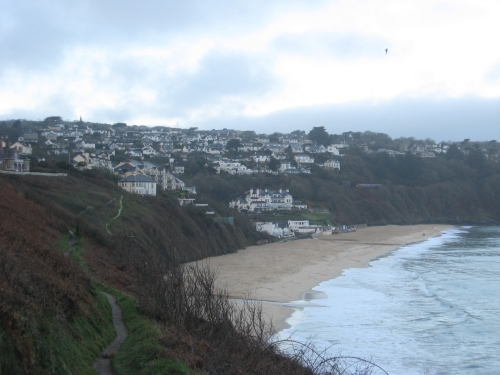 Carbis Bay, the main intermediate location between St Erth and St Ives, offers a glorious open beach at this hour of the morning at this time of year. The South West Coast Path wends along the top of the sheer drop to the sea. Hotels cling to the slopes. The train hides in plain sight, a little blue pencil rolling through the landscape.
Carbis Bay, the main intermediate location between St Erth and St Ives, offers a glorious open beach at this hour of the morning at this time of year. The South West Coast Path wends along the top of the sheer drop to the sea. Hotels cling to the slopes. The train hides in plain sight, a little blue pencil rolling through the landscape.
 Viewed from the same spot as the previous picture, St Ives nestles between the great blue sea and the deep cloud-filled blue sky in the winter dawn twilight.
Viewed from the same spot as the previous picture, St Ives nestles between the great blue sea and the deep cloud-filled blue sky in the winter dawn twilight.
 The southern parts of the town of St Ives are a jostle of larger buildings, trees and urban infrastructure, variously illuminated by the rising sun or set in shadow by the hilly landscape.
The southern parts of the town of St Ives are a jostle of larger buildings, trees and urban infrastructure, variously illuminated by the rising sun or set in shadow by the hilly landscape.
 The church, deep in the centre of the town and just above the quay, stands surrounded by palm trees, tea shops and holiday let agencies where other churches would have yews, pubs and estate agents. St Ives has a one-way system.
The church, deep in the centre of the town and just above the quay, stands surrounded by palm trees, tea shops and holiday let agencies where other churches would have yews, pubs and estate agents. St Ives has a one-way system.
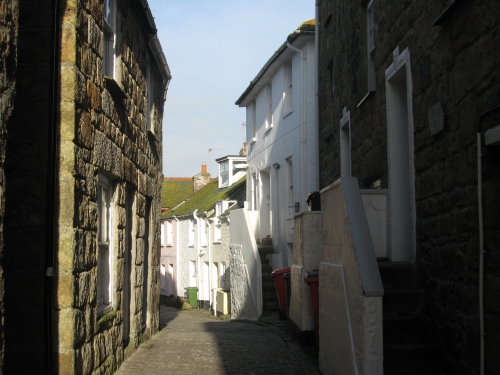 The tight back lanes of St Ives readily explain the Minister of Transport’s decision to reprieve the St Ives branchline. Cobbled roadways and no pavements combine with stone-built houses and mossy roofs to create a rather photogenic scene. Back alleys lead through to more houses scrambled away out of sight to the casual wanderer.
The tight back lanes of St Ives readily explain the Minister of Transport’s decision to reprieve the St Ives branchline. Cobbled roadways and no pavements combine with stone-built houses and mossy roofs to create a rather photogenic scene. Back alleys lead through to more houses scrambled away out of sight to the casual wanderer.
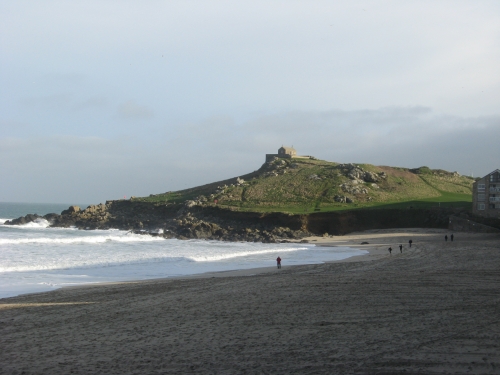 At the north end of the town, St Ives Head casts itself into shadow. The sweeping sandy beach faces out onto the fringes of the Atlantic. Atop the headland, a small chapel watches the comings and goings of the sea.
At the north end of the town, St Ives Head casts itself into shadow. The sweeping sandy beach faces out onto the fringes of the Atlantic. Atop the headland, a small chapel watches the comings and goings of the sea.
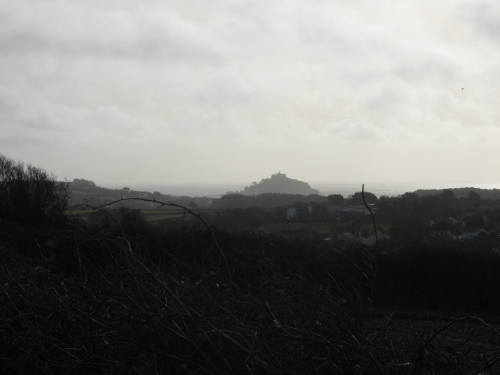 From the north coast of Cornwall at St Ives it is possible to have a very pleasant walk of nine miles or so along quiet country lanes to the south coast of Cornwall at Marazion. On the final leg of the journey, the sun casts hedgerow, buildings, trees and St Michael’s Mount into increasingly misty silhouettes against the soft grey sky.
From the north coast of Cornwall at St Ives it is possible to have a very pleasant walk of nine miles or so along quiet country lanes to the south coast of Cornwall at Marazion. On the final leg of the journey, the sun casts hedgerow, buildings, trees and St Michael’s Mount into increasingly misty silhouettes against the soft grey sky.
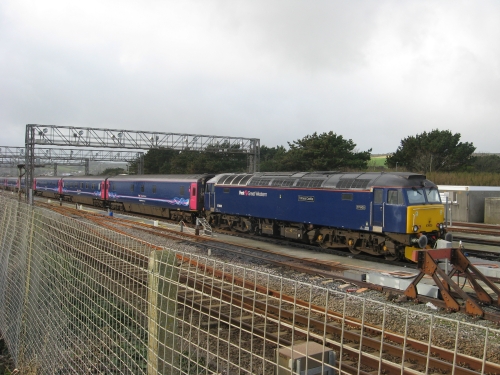 A Sleeper train in daylight – Totnes Castle sits at the Exeter end of her train awaiting the call to roll out for the next London-bound Sleeper service. Behind, a rake of sleeping cars rest under the lighting gantries of Penzance Long Rock depot. The other two Sleeper locos go by the names of Restormel Castle and Pendennis Castle. Unusually, all four carry number plates; Pendennis Castle also carries GWR lined green colours for the final historic touch.
A Sleeper train in daylight – Totnes Castle sits at the Exeter end of her train awaiting the call to roll out for the next London-bound Sleeper service. Behind, a rake of sleeping cars rest under the lighting gantries of Penzance Long Rock depot. The other two Sleeper locos go by the names of Restormel Castle and Pendennis Castle. Unusually, all four carry number plates; Pendennis Castle also carries GWR lined green colours for the final historic touch.
For variety, the journey home was made by daytime train in the company of two High Speed Train powercars called The National Trust and Christian Lewis Trust.